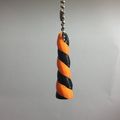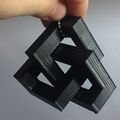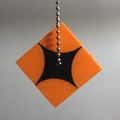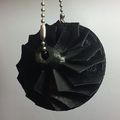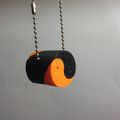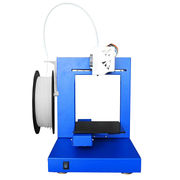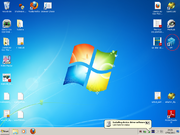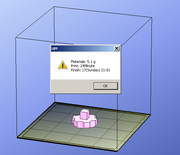Difference between revisions of "Equipment/3D Printer"
(→Gallery of 3D things printed in Makespace using Replicator 2X) |
(→Gallery of 3D things printed in Makespace using Replicator 2X) |
||
| Line 74: | Line 74: | ||
= Makerbot Replicator 2X 3D Printer = | = Makerbot Replicator 2X 3D Printer = | ||
| − | ==Gallery of 3D | + | ==Gallery of 3D printed things in Makespace using Replicator 2X== |
<gallery> | <gallery> | ||
File:Unicorn Horn.jpg|unicorn horn http://www.thingiverse.com/thing:83012 | File:Unicorn Horn.jpg|unicorn horn http://www.thingiverse.com/thing:83012 | ||
Revision as of 10:59, 9 January 2015
Class Red equipment: Do not use without specific training.
(More about equipment classes)
Contents
Introduction
3D printing is a way of creating small, custom objects from plastic filament. The printer melts the filament, held on a spool, and prints with it to create 3D structures. Makespace has two 3D printers, an UP! and a Makerbot Replicator 2X. Currently, the Makerbot is the only printer working in the space. The UP! is out of action until it can be fixed by the owners (needs new electronic components).
Owners
The Owners are those nominally in charge of the equipment, organising its maintenance, training others to use it, and generally being a point of contact.
The current Owners of the 3D printers are:
If you have any questions, problems or concerns around the 3D printer, these are the people to contact.
Trainers
The Trainers are not in charge of maintaing equipment, but have been more thoroughly instructed in its use and can train others. They may run extra classes for recently trained learners.
The current Trainers for the 3D printers are:
- Hannah Wray
- Peter Knight
- James Hutton
- Robert K.
- Johnie Waite
Training
YOU CAN ONLY USE THE 3D PRINTER IF YOU HAVE BEEN TRAINED
and have been added to the Trained Users list by one of the Owners or Trainers
To get trained on the 3D Printer and be added to the qualified user list, you will need to arrange for a training session with one of the 3D Printer Owners.
If you'd like to arrange training, please see:
Note that persons who were previously trained on the UP! are allowed to use the Makerbot after reading its manual. See https://s3.amazonaws.com/downloads.makerbot.com/replicator2x/MakerBot_Replicator_2X_User_Manual.pdf
General Health and Safety
The 3D printers are excellent tools for either making small parts, or rapid prototyping. At the same time it is an expensive tool with a (small) risk of injury and fire, so is very important you know how to use it to avoid damaging yourself and the machine. The 3D printer is a potentially dangerous piece of equipment which must only be operated by members who have received appropriate training and who take due care. The top things to always remember when using the 3D printers are:
- ONLY USE THE 3D PRINTER IF YOU HAVE BEEN TRAINED
- ONLY USE THE 3D PRINTER IF YOU HAVE READ THE INSTRUCTIONS
- NEVER LEAVE THE PRINTER RUNNING UNATTENDED
As a responsible user, you should be very aware of the following risks and how to deal with them:
HEAD CRASH - incorrect calibration could cause the nozzle to hit the platen at job start
- Calibration must be carefully checked on each startup
TRAPPING - The head and bed of the machine are moved by programs in the machine's memory.
- Be careful when near the machine, it will possibly move even if the PC is off
- Ensure you are familiar with the 'pause' and 'stop printing' functions on the Makerbot so that in an emergency you can quickly halt printing.
BURN RISK - the platen on the printers are heated, and will reach temperatures up to 253 degrees during a print run which could cause skin burns. The extrusion nozzles also get very hot. Do not touch either of these areas while printing, and keep the Makerbot's guard door securely closed while printing.
- Be careful when the machines have recently been used, as they may still be hot enough to burn.
ELECTROCUTION - as with all mains powered devices there is a small risk of danger from exposed wires. Always do a manual check that the wiring is safe, no cores are exposed or wires trapped.
Plastics used in the printers
The 3D printers can print with two different plastics, PLA and ABS. PLA has a much lower melting point than ABS, so all temperature settings for the printer need to be changed if you are switching between plastics. Normally ABS is what we would reccomend printing in: it is more durable and strong.
Telling the difference between the plastics is fairly simple: if you take a piece of the PLA filament between your fingers you can break it off and snap it easily - it is brittle. When you try to break off a piece of ABS, it bends and the filament starts to go white, not breaking straight away.
The ABS can be found on the shelves above the 3D printers, the small amount of PLA can be found in the lower down orange drawers (marked PLA).
Makerbot Replicator 2X 3D Printer
Gallery of 3D printed things in Makespace using Replicator 2X
unicorn horn http://www.thingiverse.com/thing:83012
trefoil knot http://www.thingiverse.com/thing:577364
2 color cube http://www.thingiverse.com/thing:562955
Yin Yang cylinder http://www.thingiverse.com/thing:22682
This is the Makerbot Replicator 2X, currently the only 3D printer working in the space. There is a dedicated PC next to it with the MakerWare software used to drive it. MakerWare can import STL design files (eg. from Thingiverse) for printing. The manual for this printer can be found here: https://s3.amazonaws.com/downloads.makerbot.com/replicator2x/MakerBot_Replicator_2X_User_Manual.pdf
Specific Safety Tips
There is a burn hazard from the nozzles and the heated platter, as mentioned above. The Makerbot will display its current temperatures for you if you use the arrow keys to navigate on its small display (see manual). The platter may also move unexpextedly. Do not open the front hatch or lift off the top transparent cover during printing. ABS fumes over a long period may be harmful - if you feel light-headed take a break in a well ventillated area.
Don't let the machine run unattended - you don't need to watch a print constantly but keep an eye on it and always remain in the same room. Possible problems that would require you to pause or stop the machine include filament getting wrapped around the spool holder at the back and sticking, and a software crash on the PC. If you're unsure of a situation you can always pause your print and restart it.
Always switch the printer off at the back when you are finished.
Avoiding Damage to the Machine
The bed is covered with Kapton tape. This green, shiny tape is very fragile and expensive to replace and so you MUST NOT use a knife, scraper or other sharp object to remove your finished models. Use your hands only, or the plastic scraper with the Makerbot logo on in the red box as a last resort. Often, models will easily come free once the bed is allowed to cool, so give it 10 minutes and try again before resorting to this.
The kapton tape needs to be kept clean so that plastic extruded onto it has a nice base finish and sticks well. If you notice smears or marks on the tape give it a gentle clean with a dry cloth from the red box on the shelf. Make sure your hands are clean and not greasy before you touch the platen or try to remove printed objects from it.
If you do damage the tape, please let the owners know as soon as possible. The owners group email address is on the sign on the side of the machine.
Using SD cards with the Makerbot
We would recommend driving the Makerbot directly from the dedicated software on the PC next to it. If you want to use an SD card, it is very fussy. SD cards have to be PHYSICALLY 2GB or smaller (formatting a big card small doesn't work). They also have to be formatted in FAT16 (mostly Linux machines do this most easily). There is a small card formatted this way, currently in the slot of the printer free to use. It's labelled "MAKESPACE"; please don't absent-mindedly take it away! The SD card should contain .thing files to print from.
Loading and Unloading
You will notice there are two print heads for this printer, driven by two separate spools of plastic on different axles.
When you want to change spools, either to change colour or because a spool has nearly run out, follow these instructions, found on page 31 of the Manual. Go there if you have any questions about detail or need further instructions with illustrations. https://s3.amazonaws.com/downloads.makerbot.com/replicator2x/MakerBot_Replicator_2X_User_Manual.pdf
If you need to unload the MakerBot Filament, the LCD menu will walk you through the process. To run the script for unloading the filament from either extruder, go to the LCD panel and select Utilities > Filament Options > Unload (specify left or right). The LCD menu will walk you through the process. You will need to first remove the transparent lid to access the filament tubes. Be patient - yanking at the filament before it is ready to be removed may leave residue inside the extruders which is VERY DIFFICULT TO REMOVE.
When you are ready to load a fresh filament, the menu will walk you through the process. There is no need to worry about allowing extra printing to change colours fully afterwards because you'll print a test strip during changeover that does that. There is a step of 'cut off lump' which means you'll need to use the wire cutters provided to snip away this excess lump of test printed material.
It is very important to make sure your spools are running in the correct direction. Ensure that the filament mounted on the right spool holder [when viewed from the back] unspools clockwise and that the filament mounted on the left spool unspools counterclockwise. Refer to the diagram you were shown during training, or to the manual.
Also beware of wrapping round axle - sometimes the spools can get misaligned and filament ends up tightening and wrapping around the axle. This is very dangerous and printing should be stopped straight away to correct it. There is more of a danger of this happening if the spools are set up incorrectly.
If you are changing between PLA and ABS you also need to change the temperature settings of the machine, since PLA will burn at the temperatures used for ABS, and ABS will not print at PLA temperatures.
Printing
The printer always extrudes a test line along the front of the bed first. Make sure to remove this when you remove your print, and that your print location doesn't clash with it.
Preheating the bed is helpful but not necessary - it will save you time. The printer will not print until the bed has heated up enough. You can select the left and/or right extruders to heat up as well. If you are only printing with one material, just select that extruder. Go to Utilities > Preheat > Start Preheat
If a model is stuck, wait for the bed to cool - often they will come away very easily once cooled enough. Otherwise apply a gentle twisting action manually. As a last resort, use the plastic MakerBot branded paddle to scrape it away from the bed. Do NOT use metal knives - they will damage the kapton bed.
Keep an eye on it. prints can go strange half way! Be ready to pause or stop while printing. You can find those options by pressing the left arrow while printing. You can always pause a print if you are uncertain - as long as you resume it within a couple of minutes, this shouldn't alter your final result.
Levelling
This is not often needed. The symptoms of unlevelness are:
- first layer too thin or varying thickness - part not sticking
In the worst case: the print head ends up touching the bed - HEAD CRASH. This is bad news. Level the bed before this stage is reached!
To level the bed, go to Utilities > Level Build Plate. There are 3 screws underneath the build plate - see p23 of the Manual for a diagram on where they are located. The MakerBot software will guide you through the process of adjusting them to level the plate. The ideal to aim for is that a piece of paper should *just* slide through the gap between the extruder nozzle and the plate in each location.
Be careful not to damage kapton tape while doing this!
Software
The software used with the MakerBot 2X is called MakerWare. It is well documented in the Manual and there are many online tutorials for its use, so we will not go into detail here.
Some tips on our experience with the software:
If there seems to be an unspecified software problem/crash, try selecting Services > Restart Background Service. This resets the connection to the printer. Don't do this while printing.
Edit > Settings lets you select which plastic you have loaded into each extruder. You need to change this each time you load new plastic. When switching to PLA make sure to change the temperature profile here as well as switching colours.
The Make button gives you settings for supports (colour matched is best), whether to have a raft (generally not needed), and resolution (standard is best). For a general guide, 4 shells with layer height h = 0.2mm generally works well. Experiment with infill settings - 15% is generally fine.
Multicolour
Can't do scaffolding and multicolour - This is not true anymore, we think. Issues with mixed materials. It might seem like a good idea to use a PLA scaffold for an ABS piece and then dissolve away the PLA in hot water, but this is in fact very difficult. It's better to think about scaffolding with weaker pieces of the same plastic, or changing a piece's orientation.
Other Details
Don't leave the room while printing! The printer is very expensive and you don't want to have to explain the lump of plastic stuck to a now-unusable extruder is your fault. Play it safe, keep an eye on your prints.
You need to pay for your prints once you have made them. The current rate is 10p/gram of material used - use the little scales on the shelves on top of the printer area to weigh your finished prints.
Hardware Updates
The drive blocks on both extruders are OEM, and are known to have problems with filament feeding. They are also unable to work with NinjaFlex 3D Flexible Printing Filament, of which we now have a roll. Several 3D printable repacement drive blocks are available. one of them from Makerbot. The most useful for our purposes is the "Replicator 2X Extruder Drive Block Upgrade", thingiverse #222667.
This has been printed, and all of the hardware assembled with one exception: the tension spring. In testing, the new drive block works well, BUT the spring does not provide sufficient tension. The recommended spring is from McMasters in the US (see http://www.thingiverse.com/thing:222667 for details), and we have been unable to source a cost-effective alternative in the UK. So for now, this update project is stalled. If someone wants to take on the task of finding a suitable spring, the drive block parts are on the shelf above the printer, and there is a note attached with details and contacts.
Using the UP! 3D Printer
This is the UP! (a slightly older version of the device currently available). The dedicated PC next to the printers is running win7 and UP! software. It can import STL design files from Google sketchup. At the moment the UP! is out of action.
Instructions
To use the printer you must familiarise yourself with the safety notes above and read the following instructions.
Power Up
- Give the machine a quick visual check. Make sure that there is nothing left on the platen. Remove the platen support piece from under the platen and gently lower it. Check the new material is feeding OK and the reel has enough on it
- Turn on the machine at the wall socket
- Initialise the machine - Open the 'Up!' software on the attached PC and double-click the software icon. Once it has loaded select '3D Print > Initialise' from the toolbar
Check calibration
This operation must be carried out to ensure the bed is level and has the height correct.
- Firstly find the current value of the nozzle height in the print dialog. This is only accessible once you have a design loaded, so load a model in (there should always be some in the '3D Printer Training' folder on the desktop) and then select 'Print' from the toolbar
- Note the printhead height from this dialog (currently 139.1) and press cancel to abort
- Go to the maintenance dialog (3D Print > Maintenance from toolbar) and set the head height to 20mm less than this height. Enter the value in the edit box and press 'To:' button
- Then move the bed closer to the expected value, in decreasing steps, until you reach the set height or the nozzle is going to hit the bed. If you reach the specified height (currently 139.1mm) there should just about be room to get a piece of paper between the nozzle and the bed.
- Once this has been checked you should drop the head to about '100' and then repeat the check at two other corners and the centre. When the platen is well below the head you can quickly go to the other locations using the FL/FR/NL/NR/Center buttons on the maintenance dialog
Load your Design
- Import your model - press the 'Open' icon on the ribbon bar
- Check the placing and size of your model - the printer software is quite clever, but it may not choose the best orientation of complex shapes. You want the largest flat surface on the bottom, so that less support material is required.
Download to the Printer
- When you are ready to print you can just press the 'Print' button on the ribbon bar
- Some calculations now take place and a popup box will appear with an estimate of how much material will be required as well as how long printing will take - please check 3D Printer Material Cost table and put your money in the honesty box
Worried whether there's enough filament left for your job? As a rule of thumb, one turn of the material drum is about 1g of material. - If you are happy then make a note of the material weight and check the cost against the table below
- Press 'OK' to proceed
- Watch the magic happen ...
DO NOT EVER LEAVE THE PRINTER UNATTENDED
Finishing
- When the part is finished the printer will make several beeps - but of course you will be watching so you will be expecting that
- DO NOT TOUCH THE PLATEN YET ! It is usually very hot, and it is best to give it a few minutes at least
- When it has cooled a little then with care you can peel the part away from the platen
- The 'raft' which was built to produce the part on should then separate with a little effort, and possibly careful peeling with a blade
Power Down
- Lower the platen to its rest position before turning off. Do this from the maintenance dialog (3D Print > Maintenance from the toolbar) and press 'To Bottom'
- Turn off the printer on the wall socket
- Gently lift the platen and put the platen support piece back underneath
- Shut down the PC and double check that everything is left in a safe and clean state for the next user
Cost
Currently we charge 10 pence per gram for prints, this is to cover the cost of material plus a little for wear and tear and other consumables. You can weigh printed parts using the scales next to the blue honesty box. Please put your money into the blue labelled honesty box on the shelf above the printer.
Maintenance
The maintenance of the 3D printer is carried out by the Owners, with some basic maintenance being carried out by Users on every job.
Maintenance Schedule
Continuous Maintenance (Every job, done by all 3D Printer Users)
- Clean the platen of any plastic remnants
- Check the new material is feeding OK and the reel has enough on it
Basic Maintenance (Every week, done by 3D Printer Maintainers)
- Check the security and condition of all cabling
- Check the UP! platen coating and re-paint any areas if necessary (green paint is in a pot with the printer)
Full Maintenance (Every 4 weeks, done by 3D Printer Maintainers)
- Tasks as per Basic Maintenance, plus
- Strip coating off UP! platen and re-paint with a fresh coat
- Calibration check, if issues have been reported
Maintenance Log
Reactive Maintenance
- None
Regular Maintenance
- Week Number, Date, Type, Owner (Notes)
2013
- Week 08, February 18, Simon Stirley (Re-painted holes in platen coating)
- Week 09, February 25,
- Week 10, March 4,
- Week 11, March 11, Simon Stirley (checked wiring, posted safety notice, re-painted platen holes)
- Week 12, March 18,
- Week 13, March 25,
- Week 14, April 1,
Maintenance Shopping List
- TBD
Further Information
Manual
The manual is installed in the machine attached to the printer and also available here: Manual
Repairs
We expect to have to change the following parts for general maintenance:
- TBD
Maintenance and Spares:
- One UK supplier of consumables is Cool Components
- www.shop.3dfilaprint.com/ 5% Discount code is: cambmake
Software
You can download Quickstart manual and latest driver software from pp3dp.
- Google SketchUp with STL plugin as below
- This plugin seems to work quite well. Use 'File/Export to DXF or STL' from Sketchup once you have installed it and select 'STL' as the last item in the type list when asked
- NetFabb repairs any incomplete STL files
- Meshlab is a good free program (Sourceforge) for visualising and modifying STL files
- OpenSCAD is a script-based modeller ('3D compiler'), well-suited for technical CAD (less so for artistic design)
